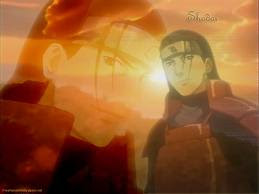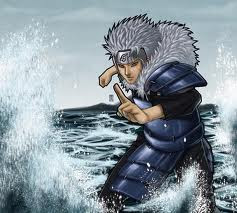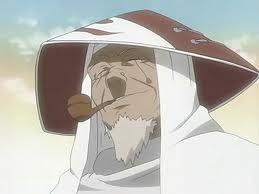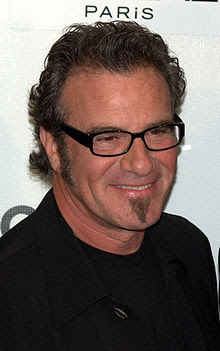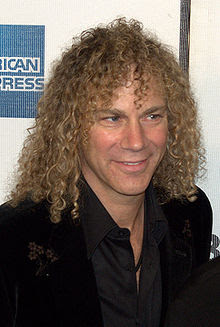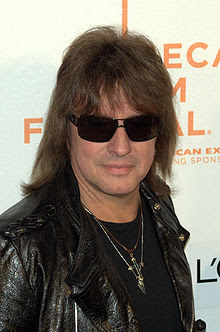Jon Bon Jovi (born
John Francis Bongiovi, Jr., on March 2, 1962) is an
American musician,
singer,
songwriter and
actor, best known as the lead singer and founder of
Bon Jovi. Throughout his career, he has released two solo albums and eleven studio albums with his band which have sold over 200 million albums worldwide.
[1]
As a solo artist, Bon Jovi has numerous awards for his work, including a
Golden Globe and an
Academy Award nomination for his solo hit:
Blaze of Glory. He was awarded an honorary Doctorate of Humanities from
Monmouth University in 2001. He campaigned for
Al Gore in the
2000 Presidential election,
John Kerry in the
2004 Presidential election, and
Barack Obama in the
2008 Presidential election.
Jon Bon Jovi was born
John Francis Bongiovi, Jr., in Perth Amboy, New Jersey the son of two former
Marines, hairdresser John Francis Bongiovi, Sr. and florist
Carol Sharkey. He has two brothers, Anthony and Matthew.
[2] His father was of
Sicilian and
Slovak ancestry and his mother was of
German and
Russian descent.
[3][4] He spent summers in
Erie, Pennsylvania, with his grandparents as a newspaper salesman.
[5] As a child, Bon Jovi attended
St. Joseph High School, in
Metuchen, New Jersey, during his freshman and sophomore years.
[6] He later transferred to
Sayreville War Memorial High School in
Parlin,
New Jersey.
[7]
Bon Jovi spent most of his adolescence bunking school to opt for music activities instead, and ended up playing in local bands with friends and his cousin
Tony Bongiovi, who owned the then famous New York recording studio,
The Power Station. As a result, his academic records displayed less than spectacular achievements and poor grades. By the time he was 16, Bon Jovi was playing clubs. It was not long before he hooked up with keyboardist David Bryan (real name: David Bryan Rashbaum), who played with him in a ten-piece rhythm and blues band called
Atlantic City Expressway. Bon Jovi also performed with bands called
The Rest,
The Lechers and
John Bongiovi and the Wild Ones.
When he was seventeen, Bon Jovi was working sweeping floors at his cousin Tony Bongiovi's recording studio. In 1980, when
Meco was there recording
Christmas in the Stars: The Star Wars Christmas Album, Bongiovi recommended Bon Jovi for the song "
R2-D2 We Wish You A Merry
Christmas." This became his first professional recording (credited as John Bongiovi).
[8] He left in 1983 when he got a record deal.
[9]
Jon Bon Jovi recorded a song,
Runaway, one of a few songs John wrote during his bus travels from Sayreville to The Power Station. He went to several record companies, including
Atlantic Records,and
Mercury (PolyGram), but they all turned him down.
Jon Bon Jovi visited the area's major rock station WAPP 103.5FM "The Apple" in New York City. He spoke directly to the promotion director John Lassman, who accepted the song "Runaway" for inclusion on the station's compilation album of local homegrown talent. Bon Jovi was initially reluctant to have it included but eventually gave them the song on which Bon Jovi had used studio musicians to play on the track. The studio musicians who helped record "Runaway" – known as The All Star Review – were guitarist Tim Pierce, keyboardist Roy Bittan, drummer Frankie LaRocka, and bassist Hugh McDonald.
Runaway became a local hit on the charts. Along the way, Mercury gave Bon Jovi a recording contract in 1983, and to promote
Runaway, Bon Jovi called up Richie Sambora, David Bryan, Tico Torres and Alec John Such and formed a band. After Bon Jovi claimed he wanted a group name (and rejecting "Johnny Electric"), one of the group suggested "
Bon Jovi", slightly changing the spelling of Jon's last name.
In October 1984, Bon Jovi supported the group
Kiss at the Queens Hall in Leeds.
With the help of their new manager
Doc McGhee, the band's debut album,
Bon Jovi, was released on January 21, 1984. The album went
gold in the US (sales of over 500,000). In 1985, Bon Jovi's second album
7800°Fahrenheit was released, but the response was poor. The turning point came when they brought in songwriter
Desmond Child for their third album,
Slippery When Wet. With Child co-writing many of their hits on this and future albums the band shot to super-stardom around the world with songs such as "
You Give Love a Bad Name", "
Livin' On A Prayer", and "
Wanted Dead or Alive". The album has sold in excess of 28 million copies worldwide since its release in late 1986.
[10]
During their 1986-1987 tour, Jon's attempt to give it his all during live shows (plus the tour's exhausting schedule) greatly strained his vocal cords. In the band's Behind The Music special, he notes that his vocal cords were given steroids to help him sing. With the help of a vocal coach, he was able to continue doing the tour. Contrary to popular belief, Bon Jovi did not have voice damage during the
New Jersey Syndicate Tour.
The next album from Bon Jovi was
New Jersey released in 1988. The album was recorded very shortly after the tour for
Slippery, because the band wanted to prove that they were not just a one hit wonder. The resulting album is a fan favorite and a mammoth commercial success, with hit songs such as "
Bad Medicine", "
Lay Your Hands on Me" and "
I'll Be There for You", which are still nightly stalwarts in their live repertoire.
Despite the band achieving massive success,
New Jersey almost led to the end of the band as they went straight back out on the road so soon after the heavy touring for their previous album. This constant living on the road almost destroyed the strong bond between the band members. Sambora is noted on the albums as co-writer for many songs, yet he resented the lack of attention that was heaped on Jon alone. As mentioned in
VH1's Behind the Music, the band members note that at the end of the tour, each band member went their separate way, even departing in separate jets after the tour ended in Guadalajara, Mexico in early 1990.
Between 1990 and 1992, members of Bon Jovi went their separate ways after the very rigorous two year
New Jersey Tour, which exceeded 200 shows on 5 continents. This time off also helped them determine where Bon Jovi would fit within the rapidly changing music scene upon their return.
In 1992, the band returned with the album Keep the Faith. The album was released in November 1992. Produced by
Bob Rock, the album signified an ending to their early metal roots in previous albums and introduced a more "rock n roll"-driven groove to the album. Much more complex, lyrically and musically, the album proved that Bon Jovi could still be a viable band in 90's, despite the industry's and audience's growing affinity for
Grunge.
In 1994, Bon Jovi released a "greatest hits" album titled
Cross Road, which also contained two new tracks: the hit singles "
Always" and "
Someday I'll Be Saturday Night". Always spent six months on the Top 10 of the Billboard Hot 100 and became one of Bon Jovi's all-time biggest hits. The song peaked at #4 on the U.S. charts and at #1 in countries across Europe, Asia and in
Australia. The single sold very well, going platinum in the U.S. That same year, bassist Alec John Such left the band, the first and only lineup change since Bon Jovi began. Hugh McDonald, who was the bassist on "Runaway", unofficially replaced Such as bassist.
Their sixth studio album
These Days was released in June 1995 to the most critical acclaim that the band had ever received. With the album
These Days, Bon Jovi took the mature rock sound they had developed on
Keep the Faith further. The record as a whole was darker and more downbeat than the usual Bon Jovi flare. By 1996, Bon Jovi had established themselves as a "force" in the music industry, proving much more durable than most of their 80's glam peers.
After another lengthy hiatus of nearly three years, during which several band members worked on independent projects, Bon Jovi regrouped in 1999 to begin work on their next studio album. Their 2000 release,
Crush, enjoyed overwhelming success all around the world, thanks in part to the smash-hit single "
It's My Life", co-written by famous Swedish producer
Max Martin.
Crush, which also produced such hits as "Say it isn't so", and helped introduce Bon Jovi to a new, younger fan base.
In late 2002,
Bounce, the band's follow-up to
Crush, hit stores. Though
Bounce did not enjoy the level of success of its predecessor, the album did produce hit singles such as "
Everyday" and the title track.
Bon Jovi's ninth studio album,
Have a Nice Day, was released in September 2005. "
Have A Nice Day" was the first single off the new album and the second single from the album "
Who Says You Can't Go Home", was released in the U.S. in the spring of 2006. In the U.S. a duet version of "Who Says You Can't Go Home" with country singer
Jennifer Nettles of the band
Sugarland was released, and in May 2006, Bon Jovi made history by becoming the first Rock & Roll Band to have a #1 hit on Billboard's Hot Country Chart. On February 11, 2007, Bon Jovi also won a
Grammy Award, for "Best Country Collaboration with Vocals" for "Who Says You Can't Go Home".
In June 2007, Bon Jovi released their studio album,
Lost Highway. The album debuted at number #1 on the Billboard charts, the first time that Bon Jovi have had a number one album on the US charts since the release of
New Jersey in 1988. Thanks to the band's new country music fanbase, the album sold 292,000 copies in its first week on sale in the U.S., and became Bon Jovi's third US number one album.
On April 6, 2009, it was announced that the Tribeca Film Festival will screen a Bon Jovi documentary called
When We Were Beautiful. The film follows the band on the Lost Highway Tour during 2008. The film is directed by Phil Griffin and will be the centerpiece of the festival and is considered a work-in-progress.In November 2009, Bon Jovi released their latest studio album
The Circle.
